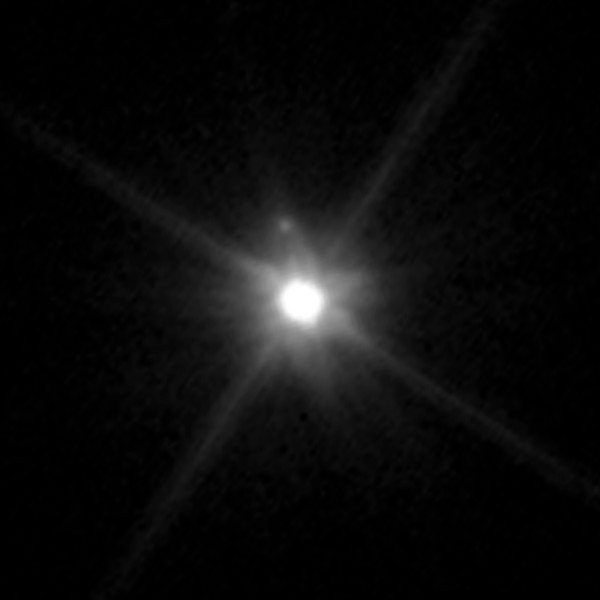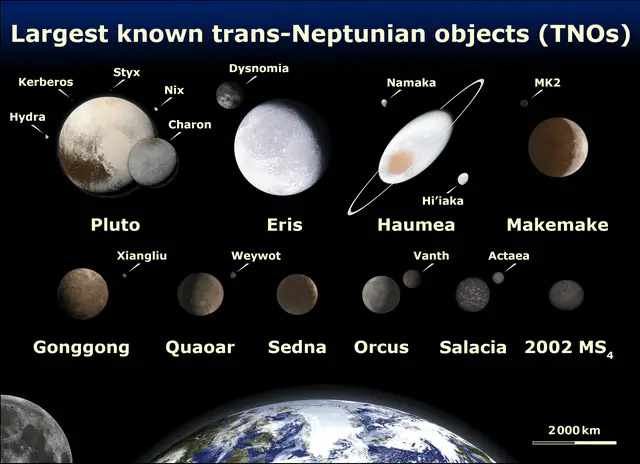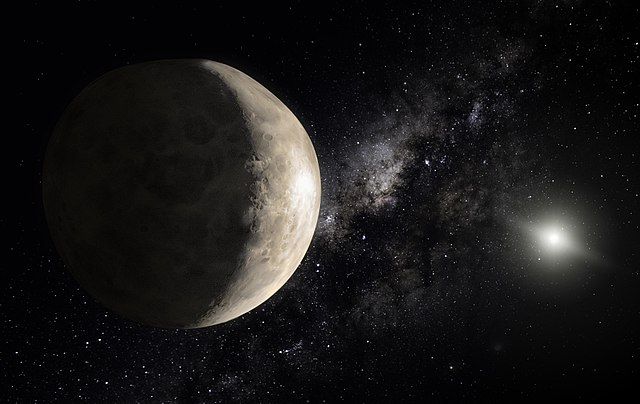The discovery of the dwarf planet Makemake is a fascinating story that provides us with an understanding of the cosmic history of our Solar System. Makemake is located in the Kuiper belt, a region of icy objects beyond Neptune – and it’s one of the most distant objects ever observed in the Solar System.
First discovered in 2005 by a team of astronomers led by Michael Brown, Makemake is the fourth-largest dwarf planet in the Solar System, with a diameter of about 1,400 kilometers. It is also the second-brightest icy object in the outer Solar System after Pluto.
Introduction
Makemake is an important object to study in order to gain a better understanding of the history of the Solar System as a whole. It provides a unique insight into the formation of the planets, as well as the other objects located in the Kuiper belt. Moreover, Makemake is an invaluable source of information about the composition of the outer Solar System and its icy bodies.
In this article, we will explore the discovery of Makemake, its location and orbit in the Solar System, its unique characteristics, and its moons. We will also look at the exploration attempts made by scientists in order to better understand this fascinating dwarf planet. Finally, we will summarize the key points of our investigation and discuss the importance of Makemake and its exploration in the future.

Hubble Space Telescope image oh MakeMake and its moon
Let’s begin our exploration of Makemake by looking at the history of its discovery. In 2005, a team of astronomers led by Michael Brown discovered Makemake, but at first, they weren’t sure what they had found. It wasn’t until later, when they identified it as a dwarf planet, that they realized the importance of their discovery.
Makemake’s official designation is the name it was given by the International Astronomical Union (IAU) upon its discovery. The name was chosen in honor of the creator god of the Rapa Nui people, who inhabit Easter Island. Makemake is the god of fertility and the chief god of the pantheon in the traditional culture of the Rapa Nui.
Makemake’s discovery is an important milestone in the exploration of the Solar System. It provides scientists with a better understanding of the outer Solar System and the objects located there. Moreover, Makemake’s discovery has enabled us to gain insight into the formation of planets and other objects in the Kuiper belt. In the following sections, we will explore Makemake in greater detail.
Uncovering Makemake’s Discovery
The discovery of Makemake, a dwarf planet, is an interesting journey that began in 2005. It was first seen by a team of astronomers from the California Institute of Technology and the University of Hawaii. They used the Hubble Space Telescope to locate Makemake in the outer reaches of our solar system.
Makemake was first identified by Michael E. Brown of the California Institute of Technology. He was searching for a new dwarf planet when he noticed an object in the Kuiper Belt that was moving too slowly to be a comet. After further observation, the object was confirmed to be Makemake.
Makemake is the second-brightest known object in the Kuiper Belt after Pluto. This made its discovery relatively easy. The dwarf planet was officially recognized by the International Astronomical Union in 2008.
Makemake is now known to be the third-largest dwarf planet in the Kuiper Belt. Its mass is estimated to be between one-third and one-half that of Pluto. It is approximately two-thirds the diameter of Pluto.
Makemake orbits the Sun in a highly elliptical path. Its average distance from the Sun is approximately 52.9 Astronomical Units, or 4.8 billion miles. Makemake takes 305 years to complete one orbit around the Sun. It is the farthest dwarf planet from Earth, at an average distance of 4.7 billion miles.
Makemake, like other objects in the Kuiper Belt, is composed of frozen water, ammonia, and methane. Its surface is covered in a thick layer of methane ice, which gives it a reddish-brown hue.
Makemake has one known, S/2015 (136472) 1. It measures only about 129 miles in diameter. It takes approximately 12 days to orbit Makemake.
The discovery of Makemake’s moons was made by a team of astronomers from the Max Planck Institute for Astronomy in Germany, using the Hubble Space Telescope. The moons were confirmed in 2016 after months of observation. This was an important step in understanding the outer solar system and the dwarf planets that inhabit it.
Makemake’s moons are the first-known natural satellites of a trans-Neptunian object. This has opened up an exciting new field of exploration and discovery. It has also contributed to our knowledge of the evolution of the solar system.
Makemake’s Orbit and Location
Makemake is one of the many dwarf planets that inhabit the outer reaches of our solar system. It orbits in a region known as the Kuiper belt, which is home to several large icy worlds beyond Neptune.
Makemake is the second-brightest dwarf planet, after Pluto, and is the fifth-most-massive body in the Kuiper belt.
Makemake’s orbit is quite elliptical, with an eccentricity of 0.16. This means that its orbit is significantly more elongated than those of the planets in our solar system.
Makemake circles the sun in a highly inclined orbit that takes approximately 311.7 years to complete.
At its perihelion, the closest point to the sun, it is located 33.3 AU (astronomical units) away. At its aphelion, its most distant point from the sun, it is located 45.7 AU away. Where AU stands for the average distance between the Earth and the Sun, which is around 93 million miles.
Makemake orbits the sun in an area known as the classical Kuiper belt, which is located beyond Neptune’s orbit. Makemake is located at a mean distance of 40.4 AU from the sun, which is nearly four times farther away than Neptune.

Due to its distance from the sun, Makemake is one of the coolest objects in the solar system, with an average temperature of -240° Celsius.
Makemake is located in an area of the solar system known as the Plutonian hill, or scattered disc, which is home to several icy dwarf planets and minor planets. Makemake is located in the inner part of this region, along with Pluto, Haumea, and Eris. It is believed that these objects were scattered away from the Kuiper belt by the gravitational influence of the giant planets.
Makemake’s orbit is also inclined at an angle of 29.6° to the ecliptic plane. This inclination is much higher than other Kuiper belt objects, and is likely due to interactions with the giant planets. Makemake’s highly inclined orbit has allowed it to avoid close encounters with the giant planets, which has likely helped it to survive in its current form.
Makemake is located in a relatively stable area of the solar system, a region known as the 5:2 mean-motion resonance with Neptune.
This region is a relatively safe zone for small bodies like Makemake, where they can remain relatively undisturbed by the gravitational influence of the giant planets. This is likely why Makemake has been able to survive in its current form.
Makemake’s Unique Characteristics
Makemake is a fascinating dwarf planet that has many unique characteristics. From its size and shape to its composition and features, Makemake is an amazing celestial body that has much to offer.
To begin, Makemake is about 870 miles across, making it slightly larger than the dwarf planet Pluto, which is about 790 miles in diameter. Makemake’s shape is quite unique, as it has a low albedo, which is the measure of how much light it reflects from the sun. This makes Makemake appear quite dark, and its surface is composed mostly of methane and nitrogen ice.
Makemake is also located in an area of the Solar System known as the Kuiper Belt, which is a region beyond the orbit of Neptune and composed of icy objects and debris. It is the third brightest object in the Kuiper Belt and experiences a long day-night cycle of about 22 hours and 45 minutes. In addition, Makemake has a rotation period of about 8 hours and 37 minutes, making one day on Makemake about twice as long as a day on Earth.
Makemake also has a unique atmosphere. The atmosphere is composed mainly of nitrogen with traces of methane. This atmosphere is quite thin, with a pressure of only 2 microbars. The temperature on Makemake’s surface is about -220 degrees Celsius, making it one of the coldest objects in the Solar System.
Makemake is also interesting in that it is the only known dwarf planet that is not tidally locked to its star. This means that it is in an orbital resonance with Neptune, where it gains and loses orbital energy with each orbit. This allows Makemake to have a more complex orbit than other dwarf planets.
Overall, Makemake is a fascinating dwarf planet that has many unique characteristics. From its low albedo and composition to its atmosphere and orbital resonance, Makemake has much to offer in terms of exploration and study. Makemake is truly an amazing celestial body that is sure to captivate the minds of scientists for years to come.
Makemake’s Moon
While Makemake’s discovery was a major achievement in itself, its moon, named after a figure of Inuit mythology, has made the dwarf planet even more noteworthy. The moon of Makemake is known as MK 2 or S/2015 (136472) 1, and was discovered in a period of just over two years between 2015 and 2017.
S/2015 (136472) 1, also known simply as “MK 2”, is located about 12,000 km away from Makemake, in a highly elliptical orbit that takes about 12 days to complete. With an estimated diameter of around 100 km, this moon is believed to have an irregular shape, making it the only known moon in the solar system to have an irregular shape of this kind.
Given its irregular orbit, Makemake’s moon is believed to be remnants of a larger body that made up part of its surface, eventually being broken up by gravitational forces over time. The moons’ relatively small size and irregular shapes suggest that Makemake may have had a violent birth, and its moons may be the result of a large impact on another celestial body.
The fact that Makemake has a moon has also generated a great deal of interest in the scientific community, as it provides scientists with an opportunity to study the dwarf planet’s formation and evolution. By studying the moons’ orbits and measurements, scientists can gain a greater understanding of the forces that shaped the dwarf planet over the years.
Makemake’s Exploration
Exploration of Makemake, the fascinating dwarf planet, has been relatively limited due to its extreme distance from Earth. Despite the great distances involved, researchers have been able to obtain valuable information about this distant celestial body through remote observations of its light curve and spectroscopic observations.
The first space mission to visit Makemake was New Horizons in 2015, when it conducted two flybys of the dwarf planet. The flybys provided scientists with invaluable data about Makemake’s surface composition, topography, and potential moons. Scientists also used this data to create detailed maps that provide an unprecedented look at the dwarf planet’s terrain.
Since then, other space missions have been exploring Makemake. In 2020, the European Space Agency’s Rosetta spacecraft conducted a flyby of the dwarf planet, providing scientists with even more valuable insights into Makemake’s environment.
During this flyby, Rosetta discovered the presence of sodium chloride, a type of salt, on the surface of Makemake. This discovery was significant because it suggested that Makemake’s surface may have been exposed to icy water in the past.
The exploration of Makemake is ongoing, and the future of exploration looks bright. Several space missions have been proposed in order to gain a better understanding of this distant world. One of the most ambitious of these proposed missions is the Makemake Orbiter and Sample Return (MOSAR) mission, which would involve the launch of an orbiter and a sample return mission to Makemake.

The MOSAR mission would provide scientists with unprecedented access to the dwarf planet and its moons, allowing them to study their geological and chemical properties in detail.
In addition, the exploration of Makemake is being conducted through a variety of ground-based telescopes. By studying the light reflected from Makemake, scientists can learn more about its composition, orbit, and other properties. This ground-based exploration is especially effective for studying Makemake’s two moons, which can be difficult to observe from space.
The exploration of Makemake is an ongoing endeavor, with the potential to reveal valuable insights about the distant dwarf planet. Through the use of space missions, ground-based telescopes, and remote observations, researchers are slowly uncovering the secrets of this far-off world.
As our understanding of Makemake continues to grow, we are sure to make exciting new discoveries about this fascinating dwarf planet.
Summary and Conclusion
The dwarf planet Makemake is a fascinating celestial body that is home to many unique characteristics. Its discovery in 2005 has provided scientists and astronomers with the opportunity to learn more about distant objects in the solar system.
Makemake orbits the sun and is located in the Kuiper belt, far from Earth. It has a unique shape and composition that make it, unlike any other known celestial body.
Makemake also has two moons, which were discovered in the mid-2010s. The moons, which have been named MK2 and MK3, are interesting objects that are believed to be similar in size to our own moon.
While further exploration of Makemake and its moons is still necessary to more fully understand the dwarf planet, these discoveries are already providing valuable insights into the celestial bodies in our solar system.
Exploration of Makemake has been challenging, due to its distant location and small size. However, astronomers have already gained insight into the planet’s orbit, composition, and characteristics. In the future, exploration of Makemake and its moons is likely to become more refined as technology advances and the capabilities of probes and spacecraft improve.
In summary, Makemake is a fascinating dwarf planet that provides astronomers with a unique opportunity to learn more about bodies in the solar system. Its discovery has opened up the door to many exciting possibilities, such as the exploration of its moons and the uncovering of further secrets about the planet’s unique characteristics.
Although further exploration is still necessary to more fully understand the dwarf planet, the discoveries made so far are highly valuable and continue to provide new insights into the celestial bodies in our solar system.
Facts
Makemake is a dwarf planet
Makemake was discovered on March 31, 2005 by a team led by Michael E. Brown
In July 2008, it was named after Makemake, a creator god in the Rapa Nui mythology of Easter Island
Makemake is currently visually the second-brightest Kuiper belt object after Pluto
The rotation period of Makemake is estimated at 22.83 hours
Makemake lacks the expected atmosphere that astronomers thought it would develop.
Makemake has a single discovered moon nicknamed MK2.
It has an extremely low average temperature, about −230 °C
Its surface is covered with methane, ethane, and possibly nitrogen ices
As of April 2019, Makemake was 7.85 billion km from the Sun
Its orbital period is 306 years
Makemake is a classical Kuiper belt object
Makemake appears red in the visible spectrum
Makemakes diameter is about 1430km
Information
| Discovery | |
|---|---|
| Discovered by |
|
| Discovery date | March 31, 2005 |
| Designations | |
|
MPC designation
|
(136472) Makemake |
| Pronunciation | mækiˈmæki |
|
Named after
|
Makemake |
|
Alternative designations
|
2005 FY9 |
| Orbital characteristics[8] | |
| Epoch May 31, 2020 (JD 2458900.5) |
|
| Earliest precovery date | January 29, 1955 |
| Aphelion | 52.756 AU (7.8922 Tm) |
| Perihelion | 38.104 AU (5.7003 Tm) |
|
Semi-major axis
|
45.430 AU (6.7962 Tm) |
| Eccentricity | 0.16126 |
|
Orbital period (sidereal)
|
306.21 yr (111,845 d) |
|
Average orbital speed
|
4.419 km/s |
|
Mean anomaly
|
165.514° |
| Inclination | 28.9835° |
|
Longitude of ascending node
|
79.620° |
|
Time of perihelion
|
17 November 2186 |
|
Argument of perihelion
|
294.834° |
| Known satellites | 1 |
| Physical characteristics | |
| Dimensions |
(1434+48
−18) × projected (1420+18 −24 km) |
|
Mean radius
|
|
| Flattening | 0.0098[c] |
|
Surface area
|
6.42×106 km2[d] |
| Volume | 1.53×109 km3[d] |
| Mass | ≈ 3.1×1021 kg |
|
Mean density
|
≈ 1.7 g/cm3 (using Ortiz et al. 2012 radius) ≈ 2.1 g/cm3 (using Brown 2013 radius) |
|
Equatorial surface gravity
|
< 0.57 m/s2 |
|
Equatorial escape velocity
|
< 0.91 km/s |
|
Sidereal rotation period
|
22.8266±0.0001 h |
|
Geometric albedo
|
0.82±0.02 geometric 0.74±0.06 Bond |
| Temperature | 32–36 K (single-terrain model) 40–44 K (two-terrain model) |
|
Spectral type
|
B−V=0.83, V−R=0.5 |
|
Apparent magnitude
|
17.0 (opposition) |
|
Absolute magnitude (H)
|
−0.12 0.049±0.020 |
